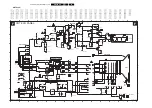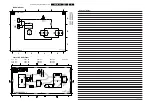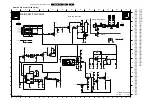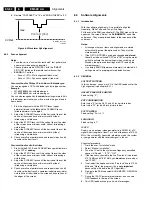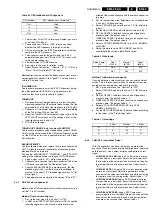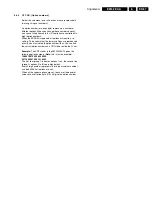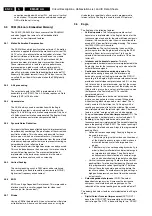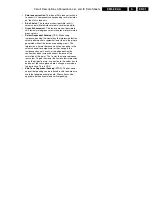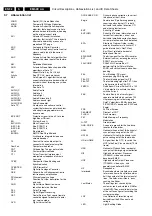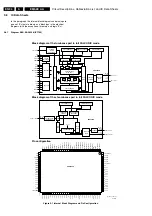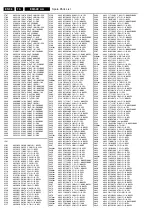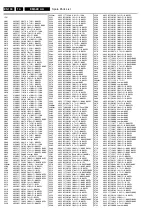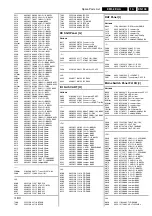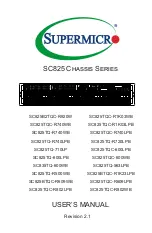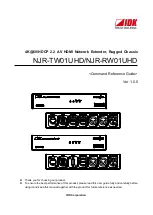
Circuit Descriptions, Abbreviation List, and IC Data Sheets
EN 89
EM5.2E AA
9.
The microprocessor, called OTC (OSD, Teletext and Control)
takes care of the analogue TXT input- and output processing.
The OTC, ROM, and RAM are supplied with 3.3 V, which is
derived from the +5V2.
The NVM (Non Volatile Memory) is used to store the settings,
one Flash-RAM contains the set software, the other Flash-
RAM (7012) is for EPG, and the DRAM is used for storing the
Teletext pages.
There is a separate Standby Supply, in order to reduce the
Standby power consumption. During Standby, the Main Supply
is switched “off” (via TS7529).
A relay (1550) is used to switch the degaussing circuit. It is
switched “on” after set start-up and switched “off” by the uP
after 12 s.
The Main Supply, an SMPS based on the “down-converter”
principle, generates the 141 V (V_BAT) and the +/- 16 V for the
audio part.
Note:
Voltage V_BAT is not mains isolated (“hot”), but is
alignment free.
9.3
Feature Box
The key components of the FBX are the following ICs:
9.4 PICNIC
9.5 FEM (Falconic Embedded Memory)
9.6 Eagle
9.4
PICNIC
All FBX versions have the PICNIC as basic IC. All functions
located in the PICNIC are therefore basic functions, and will be
described briefly. These functions are completely controlled by
the built-in microprocessor.
•
Clamp.
In the PICNIC, three analogue clamp circuits are
integrated that assure a well defined DC level for the
luminance (Y) and colour-difference (U, V) input signals.
•
AGC.
The AGC in the PICNIC consists of a digital
controlled analogue variable gain amplifier with a gain
range of 9.3 dB, and an algorithm that uses input derived
from histogram data and the overflow detection. It is
designed to assure an optimal ADC input range, for all
input signals, and so having minimal quantisation noise.
•
Analogue pre and post filters.
The pre filters of the
Feature Box are always the integrated filters of the PICNIC.
The internal post filters of the PICNIC are never used.
•
ADC/DAC.
Analogue to Digital conversion is done with
three identical 9-bit ADCs, and the Digital to Analogue
conversion uses three identical 10-bit DACs. The Y signal
is mapped on 9 bits for black-to-white range and has room
for over- and undershoots by means of the 10th bit at the
output DACs. The U and V channels are processed in 9-bit
accuracy up to the CTI circuit that has a gain of 2, resulting
in a 10-bit output that suits the 10 bit DACs.
•
Time Base Correction.
The Time Base Correction circuit
simulates a fast acquisition line locked clock, while the
actual system clock is locked to the input line frequency
with a very large time constant. In this way the typical VCR
problems linked to a one clock Feature Box can be solved,
particularly the deflection circuit (in case of CRT) driven by
the Feature Box can profit from this feature.
•
VCR detection.
The VCR detection of the PICNIC is an
algorithm that detects the phase jumps (which occurs for
instance with VCRs) to be able to correct the picture
deviations. This detection is done by monitoring the PLL
circuit in the PICNIC by the on-board microprocessor on
several parameters.
•
Peaking.
The two dimensional peaking can boost or
attenuate higher frequencies in both vertical and horizontal
direction. The lowest setting is a 2D low pass. The higher
settings make sharpening, but the resulting overshoots can
clip relatively fast compared to the dynamic peaking,
because there is no room for overshoot above white and
under black. This peaking is done on field base.
•
Digital Noise Reduction (DNR).
The PICNIC
accommodates three noise reduction circuits:
–
Clinic.
This "clamp noise reduction" circuit consists of
an adaptive temporal field recursive filter. It corrects
the DC level of each line, when it is varying from field
to field in the line segments with likely the least
movement. It can be used to correct clamp errors that
cannot be restored by conventional clamp circuits. The
filter is completely autonomous for the user, who can
only switch it “on” or “off”.
–
Limeric.
This spatial noise reduction circuit is targeted
for reduction of the mid frequency noise spectrum,
where adaptive filtering combines pixels around the
centre pixel and pixels from the lines above in a
recursive way. The quantity of noise reduction is user
defined.
–
2D Coring.
This circuit attacks spatial noise in a very
drastic way without distinguishing noise from wanted
resolution. It shaves away small details of any kind,
depending on the amplitude of the detail and the user
setting. So, it is advised to use this feature only at the
lowest settings.
•
Histogram Modification.
Using histogram modification
techniques in PICNIC, the contrast of the overall picture
may be improved. From a TV scene, the distribution of all
luminance values is taken (histogram). This histogram is
used to calculate an optimal transfer curve for the particular
scene, which is used to process the video digitally resulting
in a picture with improved contrast (called “Dynamic
Contrast”).
•
Auto Picture Control.
The PICNIC is prepared to make
several APC functions in co-operation with the main
software. This is made by giving relevant video quality data
to main, and by giving several control ‘handles’ to main
microprocessor. In this way, automatic picture quality
settings depending on customer settings and video data
can be made. The following items are prepared in the
AutoTV:
–
Automatic Picture Control.
This feature controls the
settings for DNR, Limeric, coring, sharpness and
histogram modification as a function of the noise figure
and signal steepness information extracted from the
PICNIC and from external information such as ambient
light.
–
Automatic Aspect Ratio Adaptation.
This AARA
feature uses data from the black bar detection circuit to
adapt vertical and horizontal amplitude to an aspect
ratio belonging to the display and does not show black
bars. This is done by the control software. Auto Format
is controlled via main software by reading out the black
bar information from the FBX.
•
Field Rate Upconversion.
In order to remove large area
flicker from the TV screen, the field-rate of the video is
doubled by the Feature Box. A 50/60 Hz video input is
converted to 100/120 Hz. The line frequency (16 kHz) is
also doubled (32 kHz). When the video input contains fields
A, B etc..., the conversion provides an AABB sequence
scanning on the display. The actual up-conversion is done
in the first Field Memory (FM1) by reading it twice at double
speed, while writing once.
•
Input Phase.
The horizontal phase of the input video
acquisition can be shifted to allow compensation for
processing delay of other components in front of the
Feature Box.
•
Miscellaneous Features.
To be sure that On Screen
Display (OSD) is always readable, even when no video
signal is received, the feature box can be switched to
stable OSD mode. Free running but stable horizontal and
vertical deflection drive signals will be generated, so that
OSD information and PIP can be displayed jitter free, and
thus clearly readable on the screen. Specially for tuning
purposes and smooth channel switching a stable OSD
mode is implemented that uses the horizontal time base

